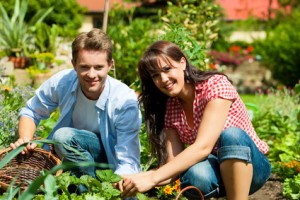 So, you purchased a home, started a home garden, and now you’re ready for the next step: growing food. Not only is vegetable gardening a fun way to reduce your grocery bills, many edible plants are also ornamental. If you think a veggie patch has to be unattractive, think again.
So, you purchased a home, started a home garden, and now you’re ready for the next step: growing food. Not only is vegetable gardening a fun way to reduce your grocery bills, many edible plants are also ornamental. If you think a veggie patch has to be unattractive, think again.
If you’re just starting out, you might want to start with a small space dedicated to vegetables. Keep in mind, though, that well-designed vegetable gardens can produce 600 to 700 pounds of produce per year per 1,000 square feet, according to the University of Kentucky’s Agricultural Department.
Even with much less space, vegetable gardens can produce an abundance of food. Because 1,000 square feet is about the size of five parking spaces, even in the space it takes to park one car, more than 100 pounds of various vegetables can be grown.
Planning a Vegetable Garden
A garden plot should have well-drained, good soil. Vegetables need at least six hours of sun per day. If dogs, cats, deer or rabbits could be a nuisance, protect the plot with a fence. The size of your vegetable garden should reflect not only the amount of space you have to work with, but also the amount of time you’re willing to spend working on it.
When planning what vegetables to plant, grow only those foods your family will eat. Plan in advance for the space a full-grown plant will require and avoid overcrowding by providing trellises to support tomatoes, pole beans, squash and cucumbers.
Taller vegetables, such as corn and artichokes, should be planted toward the rear of the garden to maximize sunlight for all plants. Permanent vegetables such as asparagus and rhubarb can occupy one side of a garden where they will not interfere with tilling.
Vegetable rows are more productive when they’re as long and continuous as possible. This allows for the best tillage and less soil compaction, giving the roots more room to breathe.
Vegetables that grow quickly – such as lettuce, spinach, radishes, beets and carrots – can be planted in multiple crops throughout spring and summer for continuous edibles.
Raised-Bed Gardening
Raised beds give the gardener the option of planting vegetables in places with poor soil quality or poor drainage. One advantage of having a raised bed vegetable garden is that the beds warm more quickly in the spring, lengthening the growing season. Also, because you don’t step onto the soil in a raised bed, the soil doesn’t get so compacted and less tilling is involved.
Raised beds can be of any size and design. They can be constructed of many things including wood, bricks, concrete blocks or even corrugated galvanized steel, and can be filled with quality soil and compost. Because raised beds drain more efficiently, they may require more frequent watering.
Container Vegetable Gardening
Not everyone has a handy backyard plot. Apartment balconies or patios and even windowsills are ideal places to grow vegetables, too, because nearly all vegetables can be grown in containers. Vegetables prefer at least six hours of sunlight a day, and plants such as tomatoes, eggplant, cucumbers and peppers need the most sunlight. Leafy vegetables, such as lettuce, spinach, cabbage and parsley can tolerate more shade.
Most vegetables will do well with 6 to 8 inches of potting soil, although root vegetables – such as beets, carrots and radishes – need deeper soil. Container vegetable gardening requires more frequent watering and fertilizer use than ground-grown vegetable gardening. If you opt for containers, be sure to check soil moisture daily.
Classes of Vegetables
When starting vegetable gardens, it helps to have an understanding of what different plants need. Here we list different classes of vegetables along with a few tips to help you get started.
- Root Crops: Cool-weather plants such as beets, carrots and parsnips can be sown early, even before light frosts end.
- Alliaceous Group: Onions, leeks and garlic are also hardy, cool-weather plants. They also can be sown early because they can withstand frost and cool weather.
- Brassicaceae Group: This cool-weather group consists of plants such as cabbage, kale, broccoli and cauliflower. In warmer climates, cabbage and kale can be started in the fall and harvested the next spring before the weather gets hot. In cooler climates, better results come from starting these plants in a hotbed or greenhouse starting in February. They can be transplanted in May or June.
- Solanaceous Group: This group includes the popular tomato, eggplant and red pepper. These vegetable plants do not tolerate frost and need longer seasons. They should be started early under glass and transplanted when the danger of frost is past.
- Cucurbitaceous Group: Cucumber, melon, squash and pumpkin are in this group. They do not tolerate frost and should not be planted until the threat of frost is past.
- Leguminous Crops: Vegetable plants in this group include peas and beans. They differ from each other significantly, though. Beans are warm-weather vegetables. Bean seeds need to be planted when soil is warm and dry to keep them from rotting. Peas are cool-weather vegetables and are among the earliest vegetables to be planted.
- Salad Plants and Pot Herbs (or Greens): Leafy vegetables make up this group. They should receive plenty of water. Almost all vegetables of this type will be sown in the spring. Most are cool-weather plants.
